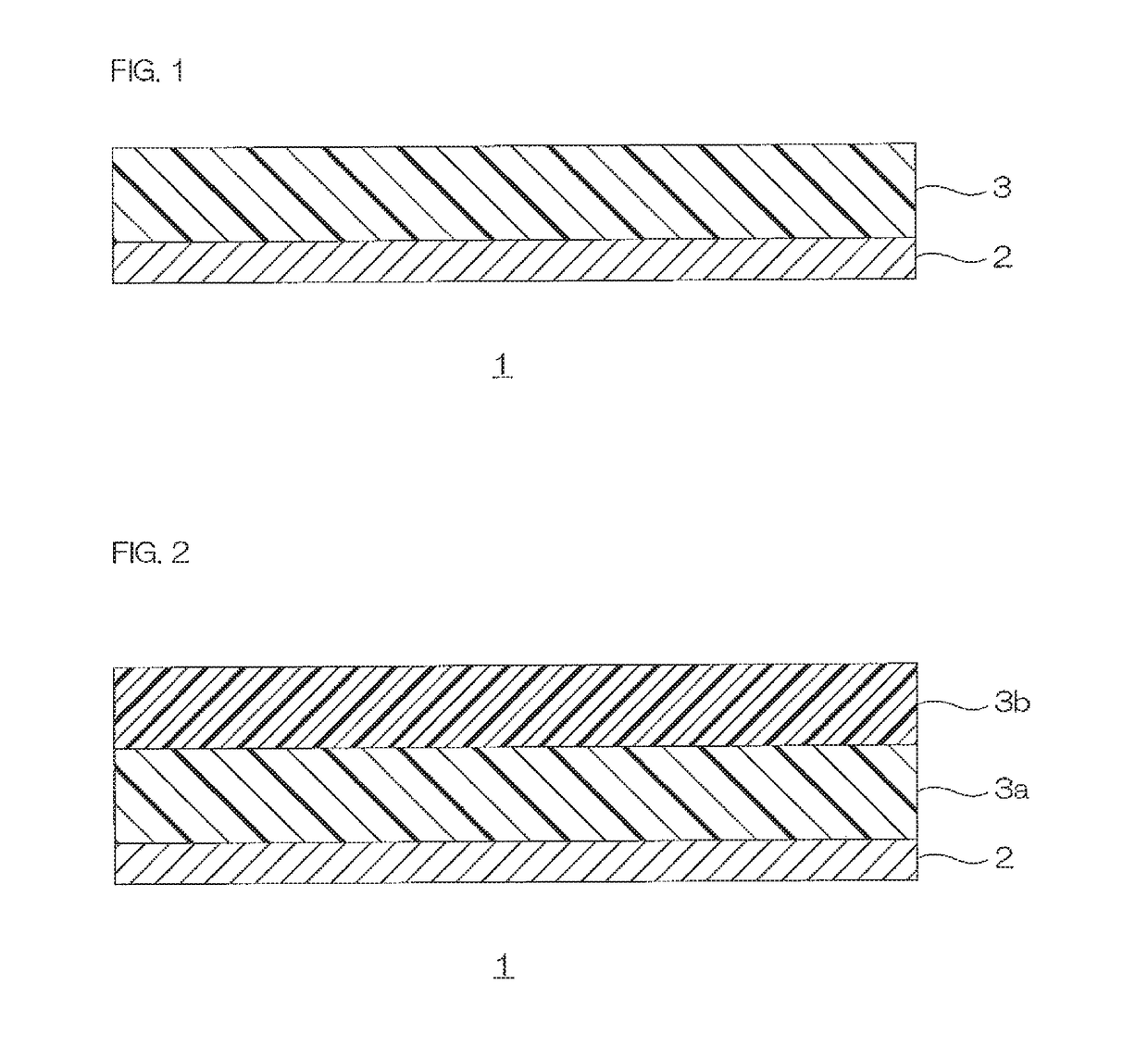Polyurethane dispersion and polyurethane laminate
a technology of polyurethane and dispersion, applied in the direction of synthetic resin layered products, coatings, chemistry apparatus and processes, etc., can solve the problems of poor gas barrier properties, low flexibility, and pvdc generate toxic gas with combustion, and achieve excellent gas barrier properties and adherence, excellent gas barrier properties, and excellent dispersion properties.
- Summary
- Abstract
- Description
- Claims
- Application Information
AI Technical Summary
Benefits of technology
Problems solved by technology
Method used
Image
Examples
example 1 (
PUD 1)
[0180]143.3 g of TAKENATE 500 (1,3-xylylene diisocyanate, m-XDI, manufactured by Mitsui Chemicals Inc.), 25.0 g of Vestanat H12MDI (4,4-methylenebis(cyclohexyl isocyanate), H12MDI), 28.1 g of ethylene glycol, 5.5 g of trimethylolpropane, 13.1 g of dimethylolpropionic acid, and 121.0 g of methyl ethyl ketone as a solvent were mixed (OH amount of low-molecular-weight polyol having a functionality of three or more / OH amount of total polyol component; 10 / 100 equivalent ratio) and reaction was performed in a nitrogen atmosphere at 65 to 70° C. until the NCO % was 6.12% or less, thereby producing a transparent isocyanate group-terminated prepolymer reaction solution.
[0181]Then, the produced reaction solution was cooled to 40° C., and thereafter, neutralized with 9.8 g of triethylamine.
[0182]Then, the reaction solution was dispersed in 839.9 g of ion-exchange water with a homodisper, and an aqueous amine solution in which 23.2 g of 2-((2-aminoethyl)amino)ethanol was dissolved in 46.5...
example 2 (
PUD 2)
[0186]142.4 g of TAKENATE 500 (1,3-xylylene diisocyanate, m-XDI, manufactured by Mitsui Chemicals Inc.), 24.8 g of Vestanat H12MDI (4,4′-methylenebis(cyclohexyl isocyanate), H12MDI), 27.9 g of ethylene glycol, 5.4 g of trimethylolpropane, 13.1 g of dimethylolpropionic acid, and 120.2 g of methyl ethyl ketone as a solvent were mixed (OH amount of low-molecular-weight polyol having a functionality of three or more / OH amount of polyol component in total; 10 / 100 equivalent ratio), and reaction was performed in a nitrogen atmosphere at 65 to 70° C. until the NCO % was 6.12% or less, thereby producing a transparent isocyanate group terminated prepolymer reaction solution.
[0187]Then, the produced reaction solution was cooled to 40° C., and thereafter, neutralized with 9.7 g of triethylamine.
[0188]Then, the reaction solution was dispersed in 842.9 g of ion-exchange water with a homodisper, and an aqueous amine solution in which 21.7 g of 2-((2-aminoethyl)amino)ethanol was dissolved in...
example 3 (
PUD 3)
[0192]144.0 g, of TAKENATE 500 (1,3-xylylene diisocyanate, m-XDI, manufactured by Mitsui Chemicals Inc.), 25.1 g of Vestanat H12MDI (4,4′-methylenebis(cyclohexyl isocyanate), H12MDI), 30.1 g of ethylene glycol, 1.5 g of glycerin, 14.0 g of dimethylolpropionic acid, and 121.2 g of methyl ethyl ketone as a solvent were mixed (OH amount of low-molecular-weight polyol having a functionality of three or more / OH amount of polyol component in total; 4 / 100 equivalent ratio), and reaction was performed in a nitrogen atmosphere at 65 to 70° C. until the NCO % was 6.15% or less, thereby producing a transparent isocyanate group-terminated prepolymer reaction solution.
[0193]Then, the produced reaction solution was cooled to 40° C., and thereafter, neutralized with 10.5 g of triethylamine.
[0194]Then, the reaction solution was dispersed in 838.7 g of ion-exchange water with a homodisper, and an aqueous amine solution in which 23.8 g of 2-((2-aminoethyl)amino)ethanol was dissolved in 47.7 g o...
PUM
| Property | Measurement | Unit |
|---|---|---|
| molar ratio | aaaaa | aaaaa |
| temperature | aaaaa | aaaaa |
| temperature | aaaaa | aaaaa |
Abstract
Description
Claims
Application Information
 Login to View More
Login to View More - R&D
- Intellectual Property
- Life Sciences
- Materials
- Tech Scout
- Unparalleled Data Quality
- Higher Quality Content
- 60% Fewer Hallucinations
Browse by: Latest US Patents, China's latest patents, Technical Efficacy Thesaurus, Application Domain, Technology Topic, Popular Technical Reports.
© 2025 PatSnap. All rights reserved.Legal|Privacy policy|Modern Slavery Act Transparency Statement|Sitemap|About US| Contact US: help@patsnap.com

